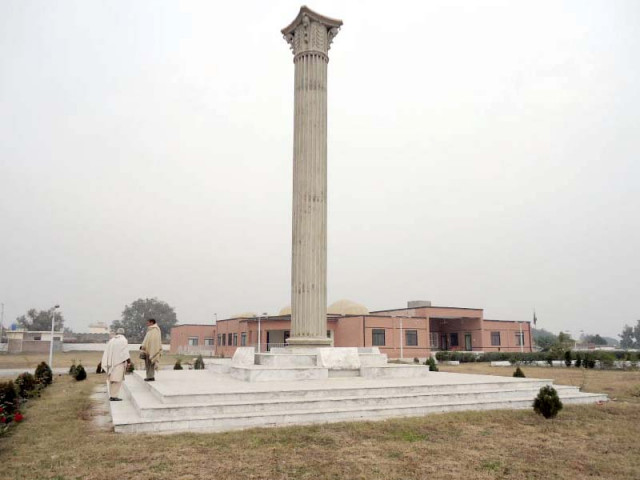
Standing on the banks of the River Indus in Hund village, Swabi, it is difficult to get an inkling of the magnificent past of this hamlet and how it dominated the history of the subcontinent once upon a time.
An intriguing symbol in this village is a Corinthian column, standing in the courtyard of a domed red brick building.
One has to travel about six kilometres through a mustard plantation and wheat fields before entering this village, which is nondescript and seems to be stuck in the winter of its past.
Before walking the narrow muddy streets of Hund, you will likely pass oxen pulling out water from wells. Once on your way to the river through these streets, you will come across the building with the Greek column in front and spacious lawns. The building houses Hund Museum, which opened a few years back.
This small village is said to be the capital of Gandhara civilisation under the Hindu Shahi dynasty in the 9th century CE.
Inside the museum, galleries of coins and Buddhist artefacts weave a colourful image of rich the cultural mosaic which flourished under the Gandhara civilisation.
“Charsadda was one of the first capitals of the Gandhara civilisation and it used to be known as Pushkalavati,” said Muhammad Asif Raza, the museum in-charge and a graduate of archaeology from the University of Peshawar.
“The capital moved to Peshawar under the Kushan Empire, and finally the Hindu Shahi dynasty made Hund the centre of the magnificent Gandhara civilisation,” he added.
He explained that Alexander the Great had spent a night in the village, before entering the Indian plains. “He entered Bajaur from Afghanistan, from where he travelled to Dir and Swat and left for India via Hund after constructing a bridge,” said Asif, adding that Syed Ahmed Shaheed Barelvi, the leader of the Tehrik Mujahideeen, had also stayed in this fort during his wars against Sikhs.
Just opposite the museum, remains of the Mughal fort dating back to the rule of Emperor Akbar are visible. However, after entering inside the wall, one enters a hamlet inside the old fort.
Kashif Khan, a local resident, explained that this small neighbourhood of around 60 households was once encircled by a wall, a part of which has been demolished now.
“Before the Grand Trunk Road was built in the 1580s, the road to India passed through this village,” he said, adding that the village has sunk into oblivion ever since the Attock crossing opened.
Dr Ahmed Hasan Dani, a chronicler of Gandhara civilisation, writes that the village was “a medieval wail hind where people used to cross the river with the help of pots.”
Asif explains that clay pots tied together served as a bridge to cross the Indus.
Dani also writes that the majority of invaders, including Scythians, Kushans, Mahmud of Ghazni, Shahabuddin Ghauri, Taimur Babar as well as Chinese pilgrims passed through Hund to enter India.
He said that the Mongol invader Changez Khan (Genghis Khan) also followed Khwarzim Shah up to Hund, before the prince jumped into the Indus River on his way to India.
It is often said that history repeats itself and present day Hund is a testimony to this fact. From the courtyard of the Hund Museum, one can see vehicles crossing the Peshawar-Islamabad Motorway Bridge over the River Indus in the winter haze.
It was in 1586 when Akbar built the Attock crossing on the River Indus and brought fishermen from Benaras to build a bridge. The construction of GT Road and Attock crossing pushed Hund into oblivion. The new motorway bridge signifies, however, that history is retracing its steps to Hund.
Published in The Express Tribune, January 1st, 2012.


















COMMENTS
Comments are moderated and generally will be posted if they are on-topic and not abusive.
For more information, please see our Comments FAQ